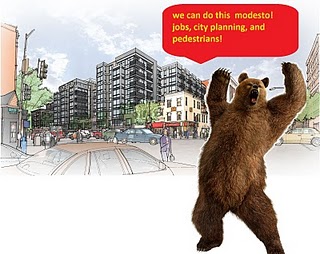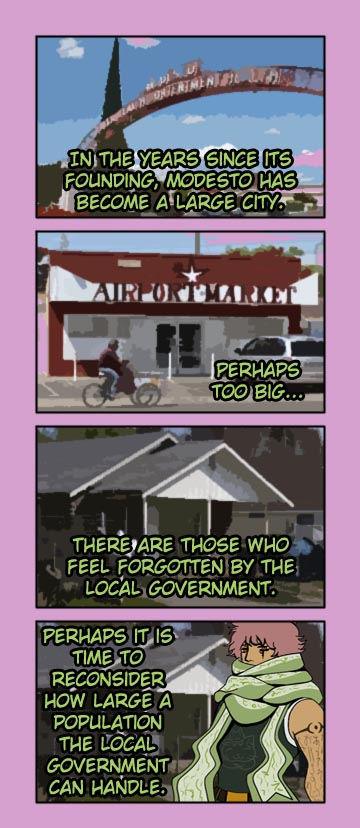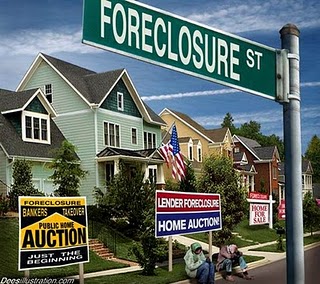Modesto airport area still isn’t at top of government’s to-do list
Carolyn Milligan lives around the corner from a broken promise. Her duplex in Modesto backs up to an empty lot. Ten years ago, the city loaned $100,000 to a nonprofit developer who promised to build houses on four such lots in the airport neighborhood.
The houses were never built and the lots are still empty. On the one near Milligan’s house, a discarded couch nestles in tall grass. The ramshackle area in southeast Modesto has made frequent appearances on city and county to-do lists over the years. It never gets to the top.
The area is home to about 500 households. Settled by Dust Bowl immigrants in the 1930s, it was once known as “Little Oklahoma.” It’s still home to families hanging on to Modesto’s bottom rung. It’s mired in poverty and crime, and lacks basic services such as sidewalks and grocery stores.
Some progress has been made. There are now curbs and gutters. A park opened behind the school in 2005, built after an 11-year lobbying effort by residents. A mobile health clinic is stationed outside the school; a sheriff’s substation opened in the neighborhood in 2003.
But despite decades of promises from city and county officials, systemic change has proved elusive. Millions of government dollars that could have shored up the neighborhood have gone unspent, and plans for the neighborhood’s revival have gathered dust in city and county offices.
In 2009, Mayor Ridenour said Modesto would receive $8 million in federal relief, $2 million of which would be aimed specifically at buying foreclosed homes in the airport neighborhood. The county doesn’t want to build sewers, curbs, sidewalks and gutters until there’s a way to pay to maintain that infrastructure.In 2006, Modesto approved an airport neighborhood revitalization strategy. The plan included building a community center on an empty lot, attracting a full-service grocery store, reviving a neglected community garden, starting a Neighborhood Watch group, starting a tool bank for residents, and giving small loans to businesses. Progress has been slow. The city won federal approval for the strategy in late 2008.
With that hurdle cleared, Modesto could have awarded federal money to organizations that directly serve the airport neighborhood. That didn’t happen until this month. In May, the City Council approved a $20,000 grant to the Healthy Start site at Orville Wright School.
Airport resident Alex Salas, 22, said he’d put more cops at the top of the list, along with a gang injunction, the anti-gang measure used to fight gang activity in south Modesto.
City officials say they’ll make better use of a second round of federal funding Modesto received in January. The city won $25 million, of which $10.5 million will pay for buying and fixing up foreclosures and vacant properties.
City staff members are recruiting a full-service grocery store. Modesto recently set aside $1.4 million in federal money for curbs, gutters and sidewalks.
The city has $94,000 in federal money to promote economic development in the area. Some of it could help neighborhood residents form small businesses. “This is real community capacity building. It’s people working with one another to achieve change. It’s working toward self-sufficiency,” Ramirez said.
The foreclosure crisis is by no means localized to the airport district, nor is it limited to the failings of home developers.
Valley residents tangled in loan-aid scam
[Merrill Balassone, May. 21, 2010]
Homeowners from seven Stanislaus County cities were among the victims of a multimillion-dollar loan modification scheme run out of a Southern California boiler room, the state attorney general said.
The victims handed over fees of as much as $5,000 to help keep their houses out of foreclosure. “I almost lost the house because I was depending on them to mediate the process and they never did,” said Jeff Carnie, an Oakdale resident who sought help from the group.
The men are accused of bilking $2.3 million from 1,500 homeowners, including some in Modesto, Turlock, Ceres, Oakdale, Riverbank, Manteca and Newman.The three-county region including Stanislaus, Merced and San Joaquin counties continues to have the highest percentage of defaulted mortgages in California.Since 2007, when the region’s housing crisis began, nearly 52,500 Stanislaus, Merced and San Joaquin County homes have been lost to foreclosure. That includes about 12.7 percent of all houses and condos in Stanislaus, 15.5 percent in Merced and 13.9 percent in San Joaquin.
These certainly aren’t the only challenges faced by home owners in Modesto. Furthermore, once a home is left vacant it becomes a community problem on many levels. What an we, average citizens, do about this? How can we re-think housing environments and the cliche of the white picket fence?
HOUSING CHALLENGE
- LEARN – Educate yourself about Recovery Act programs and outreach organizations in Modesto.
- ACT – What can you do about it? What kinds of citizen participation or collaboration are available to you? Using a self-described super power, create an alliance with an organization that either helps those who have become homeless, or that helps neighborhoods recover from empty houses and abandoned lots. Tell us about your alliance.
- IMAGINE – Unleash your creativity and see how well you can flight off foreclosure and blight!
- Ask A Mentor for Help
« Traffic: Showing Up is Half the Battle Health: Your Body, Electric »
Learn:
The burst of the housing bubble and subsequent foreclosure crisis our country has seen over the last few years has caused many people to lose their homes, forcing those with even jobs to move in with family, hop from cheap motel room to motel room and even forced some to live on the streets.
Act:
I, Adouchi, know just the way to handle this! My plan has three goals: keeping those at risk of losing their homes in their home, helping those who want to buy a home but are low income get into a home, and helping those who have lost their home into one they can afford. For my first goal, I would use my Gaze Of Justice to show those in charge of the banks that it is in their better interest as well as the public’s, not to kick people out of their homes but to work with them to keep them there. My gaze would show them how they are glutting themselves of future profit by continuing to destabilize the market and making fewer eligible buyers (as those with foreclosures on record have to wait many years to get a loan again) to make them money on new loans. My gaze would also show them that they have tightened restrictions on loans so much that now even with cheaper homes that are vastly more affordable, they are preventing many low-income people who would at these prices have mortgages lower than their rent from buying, which is preventing them from making money. For my third goal, since my Gaze of Justice is already changing the minds of bankers, how about some more government officials? Even with my gaze bankers are going to be wary of lending money out again to those who have already been foreclosed upon. I would use my gaze at the state level to allot funds for communities to buy up some of the vacant homes to be used for people who have been foreclosed on but want another shot at buying a house. The communities would rent these homes to those who have been foreclosed at rates similar to what the mortgage now (at the lower home prices) would be. Residents would be responsible for all upkeep unlike a typical rental, on the condition that after so much time of renting with on-time payments, they would then purchase the home with the government backing the loan for the same payment as their rent.
Imagine:
While my Gaze of Justice persuaded the bankers in terms they could appreciate, money, the effect is much broader than that. Citizens will rest easier and turn their attentions to more important things int he community without having to worry about if they are going to have a roof over their heads. Those unable to buy homes before in the inflated market will have a chance to become a permanent part of their community versus a temporary renter. This will keep and reoccupy homes, which keeps away crime. It is also known that owner-occupied properties are better taken care of, so it even has the possibility of making the neighborhoods even better than before the crisis started. Just imagine what people could do without that constant worry they now have.
Cave bear learns:
Deep in the mires of modesto’s airport neighborhood this cave bear listens to the barking dogs and gunshots and random drunkenness. This is a neighborhood that borders the huge Gallo plant on one side and a river on another.
But there are nice houses too. Bordering the park there are several nice places with nice cars in front. Fenced in yards and guard dogs protect the house from the sea of sweltering disenfranchisement. This neighborhood needs cave bear.
Cave bear has seen worse. Cave bear can help these people. Cave bear helped his own people form an advanced bear-civilization so this should be no problem. I will use my power of intelligence to solve these problems.
Cave bear acts:
This neighborhood is going to take lots of intelligence energy, something that cave bears don’t get without padding themselves with high protein criminals. So I crouch low in the hedge waiting for the drive by that this neighborhood is famous for……..several days later, I am stirred by a revving engine and the sound of gunfire. I spring into action and catch the car by its side and flip it over using my salmon flipping skills. The gangsters cry for mercy as I devour them slowly, enjoying them with a nice chianti and some fava beans. Lol.
There are nice families here, mostly of Hispanic nationalities. Sometimes I see them having birthday parties with lots of kids attending. Perfectly healthy. These people are my allies. I know a guy, Peter Barosso is his name and his girlfriend’s parents live in this neighborhood on Tenaya dr. near the park. He had to drive through this shanty town to pick her up when dating. So he knows all about this place.
Every bear knows that the first step in fixing people problems is education. Like the forest fire issue, people won’t act unless they have been educated that there is a problem. That’s where I enlist the help of hardened criminals turned motivational speakers, psychiatrists, social workers, police, therapists, and fellow bears to organize and direct. The bears of course are trained ninjas and will be training the people in the ninja discipline in order to teach them self esteem.
This will be a long and arduous process. First we will call a mandatory meeting of everyone in the hood. Then we will explain our plan and get them to buy off. They will buy off because no one likes being poor and down and out. What most of these people need is a reason to succeed. Many of them are of course mentally ill and will require medication to return them to healthy states of mind. Others need support groups to deal with their laziness or hopelessness. Great big bear-dumpsters are being brought in to clear the junk from people yards. Free online colleges are donating classes to people who want a better life while teachers are helping people realize that wearing saggy pants, speaking in improper English, and hating white people are not the way to go. Anger management specialists are here to teach people that only they are to blame for their conundrum.
Cave bear imagines:
5 years later: this neighborhood has been transformed into a utopia. Although heavily medicated for depression and anxiety, the people have reclaimed their streets and rebuilt their houses and yards. Where illiteracy and low IQs ruled the day, genius and scholarship now dominate. The new president (not obama, he was defeated in 2012) has declared south modesto to be a model for the world. Where there was rampant drugs and alcoholism there is now methadone clinics and rehab centers servicing the greater modesto area. People are educated darn it and it feels great. The homeless people now have permanent addresses and are either medicated or institutionalized and working in various capacities. Peter’s girlfriend says that this is a nice neighborhood and wouldn’t mind raising kids here…uh oh….


Doctor Jerry Rytloc’s Journal Entry #9: Mission 5 – Housing (commence)
LEARN:
People are being scammed?! What’s this, I got to do something about it! I understand that the banks are not loaning home buyers the money they need to purchase a house because of the state in which our economy is in.
ACT:
I will inform people or first time home buyers on how to manage their assets and money BEFORE diving into buying a home. We got to educate first time home buyers and walk them through step by step so they don’t get a loan scam or end up buying a house they can’t afford and later abandoning it! Free information should be made available for people who are looking to buying a home. I understand that it is harder to get a loan if your credit score isn’t so good but we’ll just have to find a way to work with that. Banks are reluctant to hand out loans at this time but it’s not entirely impossible to get a loan!
IMAGINE:
If I Healzor have all the resources in the world I would make sure that the process of buying a home will be less stressful. The loan process can take a long time and not even that, looking for a house that suits you takes a while as well. I’ll make sure the buyer is dedicated to making the payments and keeping up with the home and property taxes. People need to just understand that loans are serious business and if they want to keep their house they have to understand and make sure that they can afford it with their income and continue making payments over the years so it doesn’t go into foreclosure.
Doctor Jerry Rytloc’s Journal Entry #8: Mission 5 – Housing (Preview)
First time home buyers are being scam! The housing market is a mess! Banks! Loans! I must let the people know and find ways to better manage themselves and their money before diving into such a rewarding yet perilous process!


Learn: the housing situation is a huge mess. A combination of government regulations that allowed banks to sell to buyers who couldn’t afford homes, and adjustable rate mortgages that took people by surprise have really messed things up.
Act: I’ll work with the nsp to keep people in thier homes. I’ll also try to organize community service efforts like habitat for humanity to fix up homes, and board up abandoned ones so they don’t become targets for crime.
imagine: Now families are back on thier feet, and in thier homes. also many people are enjoying home upgrades, and new found friendships and community form the people that helped them. The crime surrounding abandoned houses has also fallen.
LEARN
The high rates of foreclosure in Modesto affect the citizens and the community in ways nobody had predicted. The Neighborhood Stabilization Program was created to purchase and redevelop foreclosed and abandoned homes.
ACT
I will make an alliance with the Community Housing & Shelter Services. I will use my power of accelerated plant growth laser vision thingy to help provide food for people that were left homeless…I don’t know how else I could use my powers to help the homeless…or how to help the homeless without superpowers for that matter.
IMAGINE
Umm, my powers didn’t make much of a difference I guess. I saved the Shelter money on food. They had the ability to use that money to help families find jobs so they can afford housing. Other than that…um…I didn’t help much.
LEARN: Modesto is in huge trouble! From what I’ve gathered, a large portion of the city is just in a huge state of disrepair. The will and the desire to fix parts of the city are there, but is the money available? All of the answers seem to indicate a resounding “NO”.
I mean, really, think about it. Modesto s a growing city, but the quality of life for the people there just seems to go down. Crime is high, its hard to keep your health and your home.The people moving to the city aren’t engineers or marketing gurus. They’re just normal, or even people with very little working potential. Modesto seems like a city spread too thinly.
ACT: With money being what is it, some projects are just going to have to be abandoned. There’s only so much money allotted for city repairs. One has to look at the big picture. The amount of people a project will help needs to justify the amount of money going into it. If a city project will only help a tiny fraction of the population, but cost millions, there needs to be a very, VERY compelling reason.
This might sound cruel, but those living in Modesto need to realize the farther they live in from the center, the less they’re going to get. Modesto cannot afford to pay to keep its huge size going anymore. It’s similar to what the British Empire was going through years ago. They had territories all over the world, but became spread too thin like not enough butter on toast. For fear of the whole kingdom crumbling, they cut away the excess areas down to the lands they could afford. I don’t know if it’s possible, but can a city do the same? If there are parts e living there should talk to the authorities and e living there should talk to the authorities about leaving Modesto district and forming their own city if they are particularly impatient. The simple math of it is, does it make sense to spend that much money on so few people? It becomes an example of a bridge to nowhere type of thing. It might be nice to say, clean up the Airport area, but the number of people living there might not warrant the money put in. That means the people living in the airport area can either grin and bare it or, failing that, try to separate from Modesto and become its own city.
IMAGINE: Money might not be the root of all evil, but its starting to look like the root of most problems in Modesto at least. If I had all the money in the world, people living in the often times forgotten parts of Modesto wont’ have to move or declare their own city-hood. That’s something! No, actually, they would. Declare city-hood that is. In fact, I would buy a whole chunk of Modesto and fix it up nice and pretty. I would buy all the houses and renovate. Then I would turn around and rent the houses back to the people. They’d get to live in a nice private city where everything looks good. They’ll be happy I’m sure. Or they can leave. That’s always an option, even in my power fantasies.


Learn:



What a sad, sad world we live in when almost every block is filled with foreclosure signs. What are people to hope for when most people’s dreams and aspirations revolve around owning/ living in a house?
I know several families that are at risk of losing their house or that have already lost their house. The common reason being for most people losing their house is that banks simply are not willing to work with families in need. As well as making the process of trying to negotiate the mortgage payments long and tiring. Not only that but for some strange reason new housing developments are being established which is just ridiculous because people can’t even afford to live in the houses they already own. Thank goodness there are recovery act programs that are working on putting a stop to these housing problems. The two programs I found would be beneficial are Neighborhood stabilization Program (NSP) and Making Home Affordable Program (MHAP). The NSP focuses on stabilizing communities that have suffered from foreclosures and abandonment through the purchase and redevelopment of foreclosed and abandoned homes and residential properties. MHAP Program is part of the Obama Administration’s strategy to get the economy and the housing market back on track. MHAP because the costs of houses are in fact outrageous with all these lay-offs and pay-cuts families are struggling to provide the basic necessities and on top of that they have to stress about how they are going to make their mortgage payment. No wonder the world is going down the drain, because stress is attacking everyone. Enough of this learning it’s time for me Fierce Dreamer to step in and help those keep their houses.
Act:

We citizens are the heart of the community and if we all unite and join forces we could help put a stop to this tragedy of foreclosures that are causing our fellow neighbors to become homeless. One group that I Fierce Dreamer will form an alliance with is the Homelessness Prevention and Rapid Re-Housing Program (HPRP). This program focuses on providing families with financial assistance to prevent them from becoming homeless and also provide them with credit counseling. The special thing about this recovery act program is that it provides assistance to potential homeless by re-housing them in a short or medium term rental housing location. One way I Fierce Dreamer and the community can help HPRP is by lending a hand. First I will cause all those that are at risk of losing their house and those that are considered to be homeless to enter a dream like trance where they see themselves one day owning a house again without the stress of worry about how they will pay their mortgage. Then I Fierce Dreamer and the follow community members will volunteer at the HPRP to help move people into their relocation housing. Also we will put up flyers to let people know where HPRP is located so they can make donations of food or clothes.
Imagine:
Oh it’s just so delightful to be able to walk down the neighborhood streets without being bombarded with all these foreclosure signs plastered everywhere. I mean I still might see a sign every now and then by its amazing how one little step could make a big difference. Five years later and foreclosure is no longer a fear or an epidemic taking over every block. HPRP not only gave people a new place to live, but in fact it gave people the much needed assistance to get back on their feet and be home owners again.
ACT:

The foreclosure crisis has hit Modesto like a ton of bricks. We’re hurting as a community. More and more families have lost their homes or are considering walking away.
Being a homeowner myself, I know how hard this situation is and I feel for the families who are suffering. When reading online statistics, I learned that one in eight families have been displaced, which makes the valley the nation’s foreclosure epicenter. When will this nightmare end?!?
This really made an impression on me from one of the links provided – “It is extraordinary how much can be achieved when we join together and collaborate. Through continuous partnerships with citizens, organizations and businesses, we accomplish common goals. As citizens, you are the heart of community well-being. Time and again you prove to be committed to the improvement of vitality and quality of life in our city.”
As citizens, we can help our city. Businesses and organizations need to come together to help the city of Modesto. If families are forced to leave our community, businesses suffer. Collaborating with others and building relationships can really make a difference. I am fortunate to have a home to live in. My children have a roof over their heads and a warm bed to lay in. I AM LUCKY. I need to help those in need.
LEARN:
I want to work with the City of Modesto and help with their Recovery Act Programs. The Homelessness Prevention and Rapid Re-Housing Program (HPRP) helps those who are experiencing homelessness. They provide financial assistance and help to prevent families from becoming homeless. I want them to know Supermom is here to support those in need. Families need to feel secure. Children should not have to suffer because of this housing crisis.
I want to help spread the word and get other citizens involved. We need to take action together. The emergency shelters need assistance. I will encourage donations of any kind whether it’s money, food, etc. from families and/or businesses. Charitable contributions need to be directed to our own communities. Local businesses and influential people in the community need to get creative. Talk to neighbors, church groups and anyone who cares.
More and more vacant homes are affecting neighborhoods. People are complaining about home values dropping and unkempt lawns. Well it’s time to do something about it. Quit complaining and take back your street! The government and banks aren’t going to do it for you. Yes, it requires some effort, but with a neighborhood that cares, everyone can get involved and feel good about their street again. In fact, my husband mowed our neighbors lawn when their house was abandoned. Our next door neighbor also watered their lawn. This kept our street looking cared for until the new family moved in.
Here are a few tips to help. Set up a neighborhood watch and report suspicious behavior. Be aware when neighbors move out. When a house is vacant, check for trash. No one wants rats around. Mow the lawn and keep weeds away. Report broken windows to the county officials.
IMAGINE:

Neighbors are being pro-active. It hit them that if they help others, they’re really helping themselves. Streets look cleaner and home values are looking better. Businesses are joining together with citizens to help struggling families. The problem is still ongoing, but communities are joining together to make a difference.
Let me just start off this week’s super hero adventure with a rant. What is happening to Modesto’s housing market?!?! Even in the neighborhood where my alter-ego’s and my secret lair is the sidewalks are littered with foreclosure signs.
Corrupt Angel Investigates: So this super hero decided the best way to learn about the housing problem in Modesto was to head to the more under-privileged neighborhoods and see the areas that are being hit hardest by the problem first hand. Let me just say, some neighborhoods are looking like ghost towns. Homes are boarded up to keep people from “squatting” in them, lawns are browned with neglect, windows are broken……it’s a pretty sad and discouraging image to come home to if you live next door I imagine. Well off to the internet to research what programs exist here in Modesto to help the neighborhoods heal and recover.
Well I was relieved to find out that Modesto already has a program established to deal with the foreclosure crisis, it’s called the Neighborhood Stabilization Program (NSP). Good news is it’s already federally funded…..so I won’t have to use my mind warp to “convince” people to open their wallets again. Basically, the NSP targets neighborhoods hit hardest by foreclosures (ones like my own) and purchases the homes, fixes them up, and then offers new purchasers incentives and counseling (so they know what they’re getting themselves into….mortgages can be tricky to understand. All that financial lingo is tough) to buy the once abandoned homes. Sounds pretty good.
Turns out there also is this great non-profit volunteer organization out there called No Homeowner Left Behind that is operating right here in the Central Valley. They offer loan counseling to new homeowners as well as existing homeowners in fear of foreclosure…..As part of my efforts to help save Modesto’s homeowners I will spread the word about this group. here’s a video from a local event they did
Now to help……
Act: Well this super hero will not sit idly by while efforts are being made to help the community. I will join forces with No Homeowner Left Behind and the NSP to assure my neighborhood and all of Modesto recovers. No Homeowner Left Behind holds frequent workshops throughout the valley and I will spread the word to all of Modesto. If you need help with your mortgage woes, I’ll find you the advice you seek. Meanwhile, when the NSP comes to my area to fix the abandoned homes I’ll be there to lend a hand and I’ll enlist the help of my fellow neighbors. Since much of the budget is spent on acquisition of these homes, volunteer efforts are needed in doing the maintenance and renovation.We will be cleaning yards, planting grass, painting houses, and fixing the homes to make them suitable to live in again.
Imagine: It’s been five long years and recovery has been a long road. There are fewer foreclosure signs on my block and far less people feeling the crunch of excessive mortgages. We’re still out there fixing up the homes that do become abandoned and making sure our neighborhood doesn’t fall into ruin, No Homeowner Left Behind is still offering advice to those who need it, and my neighborhood doesn’t look like a ghost town anymore.
Mowing a neighbor’s yard is a nice thing to do when there is no one home…
I imagine a community where houses are valued at affordable prices and the mortgage companies have a stake in keeping people in their homes. The Debt Destroyer could be of thunderous help!